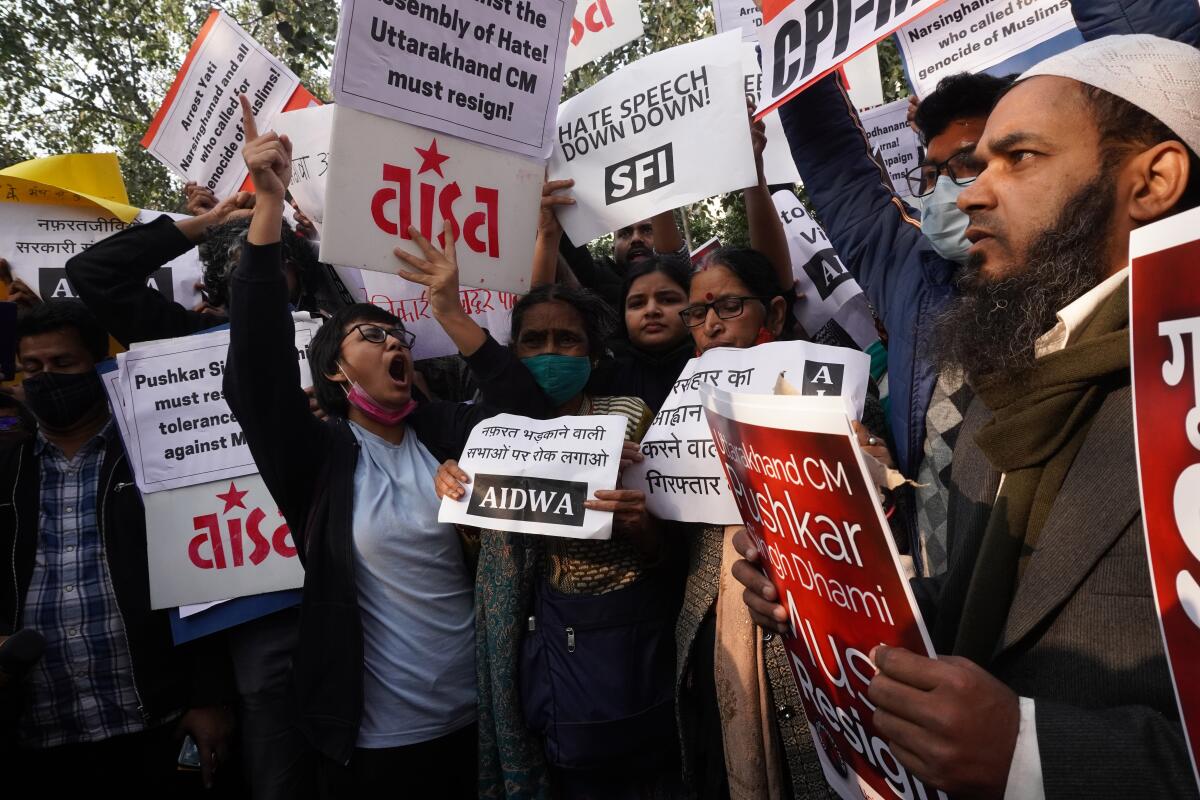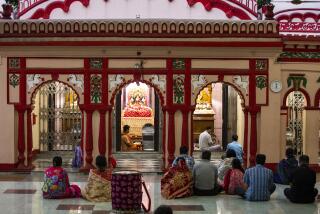Hate crimes and hate speech are on the rise in India. Meet the trackers

- Share via
MUMBAI — On a hot humid day in early June, Hindu activist Sambhaji Salunkhe delivered a charged speech in the city of Kolhapur, rehashing far-right conspiracy theories about Muslim men who allegedly court Hindu women so they will marry and convert to Islam.
His audience was already incensed about an Instagram post, uploaded the day before by a couple of local Muslim teenagers, praising the Mughal emperor Aurangzeb, a 17th-century ruler regarded as an oppressor by far-right Hindus and a hero by many Muslims. When Salunkhe told the throng to assemble the following morning to protest, the crowd roared its approval.
At 8 a.m. the following day, about 5,000 Hindus converged at the designated spot in Kolhapur. The gathering quickly transformed into a mob that vandalized and ransacked Muslim-owned shops, vehicles and homes.
Much of the mainstream media here described the incident simply as “clashes” between the two communities, but one news organization had a detailed account of the Hindu-on-Muslim violence: “The right-wing outfits, claiming that the Hindu sentiments had been hurt, called for a shutdown of the district... The demonstrators became aggressive and a mob entered Muslim-dominated localities, resorting to stone-pelting, destroying shop facades and overturning handcarts.”
The report came from Hindutva Watch (HW), a Washington-based project that monitors hate speech and hate crimes against India’s religious minorities, including Muslims, who account for 14% of the country’s 1.4 billion population. From its launch in 2021, Hindutva Watch has been a thorn in the side of Hindu nationalists who have been provoking anti-Muslim sentiment for years.
Founder Raqib Naik and his 13-member team — all self exiles based in Europe and America — have archived more than 1,200 videos on the HW website, notching up millions of views. “I wanted to create a single space where all the hate crimes against minorities are cataloged and archived,” Naik, 28, said. “Anyone interested in the rise of Hindu nationalism in India should be able to find it under one roof.”
The oppression of Muslims in India — fueled by Hindu nationalism — has become so common that observers say it’s raising doubts about its future as a secular state — and the world’s largest democracy.
Since Narendra Modi, leader of the ruling Bharatiya Janata Party, became the prime minister of India in 2014, hate speech and hate crimes against India’s religious minorities — particularly Muslims — have increased at an alarming rate. In September, Hindutva Watch reported that in the first six months of this year “nearly 80% of the hate speech events were held in Bharatiya Janata Party-ruled states or territories controlled by the BJP-led central government. This statistic is particularly striking, considering that only 45 % of India’s population falls under BJP rule.”
“The BJP has sent a message that it’s OK to go after Muslims,” Aakar Patel, chair of Amnesty International India, said last year. “This is why we’re seeing attacks and persecution.”
:::
Naik was born in Kashmir, a region in northwest India that is claimed by both India and Pakistan and is one of the world’s most militarized zones. News reports accuse India of grievous human rights abuses in the area.
Early in his career, Naik was based in Kashmir, reporting on atrocities against civilians at the hands of Indian security forces. He was on a trip to Washington, D.C., in August 2020 when he tweeted about a civilian who was killed in the custody of security forces in Kashmir. That’s when those forces started harassing his family, and he decided to remain in the U.S.
“Being a Kashmiri, Muslim and a journalist is a deadly combination in India,” Naik said. “It forced me to take this journey.”
Naik started by monitoring the social media accounts of far-right leaders in India, who travel across the country, deliver hate speeches and even upload them on their social media platforms. “The social media activity of far-right leaders is meant to communicate with their base,” Naik said. “It is a message that the work of making India into a Hindu supremacist nation is ongoing undeterred.”
He says Indians can’t find those stories in mainstream media because it has stopped much of its reporting on hate speech and hate crimes.
A year ago, Anil Yadav, a reporter based in India’s northern state of Uttar Pradesh left his job at a Hindi television channel and made a video explaining his decision. “I feel ashamed calling myself a journalist,” he said, explaining he had instructions from the top to criticize only the opposition party leaders — not Modi’s party. In addition, he said the reporters were told to “find controversies related to Muslims, instigate Muslims, get them to make controversial statements.”
A journalist working at another TV station in the state of Maharashtra has had a similar experience. “The idea is to make sure the ruling BJP looks good,” he said, requesting anonymity because he fears he will lose his job. “The far-right leaders aren’t to be exposed. We have families to look after so we have to toe the line. But what we are asked to do is not journalism. It is PR.”
Naik believes that Hindutva Watch, which has more than 75,000 followers on X, formerly known as Twitter, can help fill the void.
“We always wanted human rights groups, journalists, think tanks and authorities around the world to engage with our work, which has begun to happen,” Naik said. “That’s how you build pressure. We want to affect change in India. We want policymakers to act on what we have been exposing.”
“India doesn’t recognize hate crimes as a category of violence,” Amnesty International’s Patel said in an interview. “The National Crime Records Bureau, which publishes numbers annually, doesn’t do so for hate crimes and so there is no official data, which makes it vital to have a hate tracker.”
:::
Kolhapur is in the state of Maharashtra, which is under Bharatiya Janata Party rule. After Hindutva Watch reported on the violence in June, the state took action. But it wasn’t the action Naik had hoped for.
The police filed a complaint against Hindutva Watch, under the penal code, for spreading enmity between the Hindu and Mulim communities. “We were charged with what the far-right leader had done,” said Naik, who was not named. “It is ridiculous. But it isn’t surprising.”
In the meantime, he’s dealing with demands to take down Hindutva Watch content. In November 2022, Hindutva Watch shared a video showing Sant Yuvraj Maharaj, a Hindu militant leader, calling on Hindus to buy swords for protection against Muslims. The Indian government sent an official correspondence to X, stating that the post was in violation of India’s information technology act, and the social media website took it down.
When a reporter sent X an email asking for a comment, the reply was : “Busy now, please check back later.”
Parth M.N. is a special correspondent.
More to Read
Sign up for Essential California
The most important California stories and recommendations in your inbox every morning.
You may occasionally receive promotional content from the Los Angeles Times.










